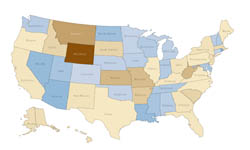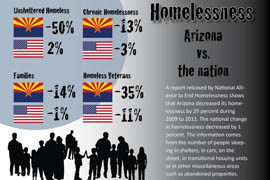Cronkite News has moved to a new home at cronkitenews.azpbs.org. Use this site to search archives from 2011 to May 2015. You can search the new site for current stories.
State posts large drop in homeless numbers, but advocates question count
WASHINGTON – Arizona posted the nation’s second-biggest percentage drop in its homeless population over the last three years, falling 29 percent in the state compared to 1 percent nationally during the same period, a new report says.
Besides the overall homeless population, the reported number of chronic homeless, homeless veterans, unsheltered homeless and homeless families in Arizona all fell faster than the national percentages in those categories, according to the report.
But some experts think the decline could be the result of a change in the way Arizona counts homeless residents, and not an actual decline in numbers.
“I’m reluctant to say, ‘Yea, we did that,’ until we have one more street count and we know how valid it is,” said Donna Bleyle, state homeless coordinator for the Arizona Department of Economic Security, of the new numbers.
The state counts homeless people in shelters annually, while “street counts” of unsheltered homeless are required every other year. Street counts identify and tally people who appear to be homeless.
In the past, the state had identified homeless people by gender, family status and youth status – something that could be done for people living on the street merely by eyeballing them in a street count, officials said.
But in January 2011, the U.S. Department of Housing and Urban Development required that homeless veterans also be identified, something that could not be done with the old street count method. Instead, officials had to go out and talk to people who appeared to be homeless and ask more detailed questions of them, said Brande Mead, human services program manager for Maricopa Association of Governments.
Bleyle concedes that officials may have been “overestimating when we were just pointing at people and determining they were homeless.”
Under the new method, the total number of homeless in the state fell from 14,721 in 2009 to 10,504 in 2011, while the number of “unsheltered” homeless fell a whopping 50 percent, from 6,355 to 3,202.
The question for advocates is whether the drop is real.
“We’re sort of treating last year’s count as a baseline and then we’ll be able to make comparisons,” Mead said.
The authors of the National Alliance to End Homelessness report that identified the Arizona drop said their report tends to focus on national statistics and trends because states can differ in strategies to count homeless residents.
“A lot of the places where we see a big change – some of that might be due to change in methodology,” said Steve Berg, vice president of programs and policy for the alliance.
Numbers aside, Bleyle said Arizona is leading the nation in many ways when it comes to best practices for reducing homelessness. Developing a more detailed survey of unsheltered homeless people is just one of those ways, she said.
“We have been getting better at what we do and pulling new methods that are getting better results,” she said.
But Joan Serviss, executive director of Arizona Coalition to End Homelessness, said there is still cause for concern for homelessness in the state, despite the apparent reduction in numbers.
“Homelessness is a lagging indicator,” Serviss said. “They wear down their support system and then they show up at the front door of a shelter.”
Arizona’s high foreclosure and unemployment rates combined with the expiration of federal stimulus grants will create a difficult year for getting homeless residents off the street, Serviss said.
“The fact that the state budget hasn’t shown any increase to support homelessness – that’s not helpful,” she said. “We’re able to very strategically use our resources the best we can.”








